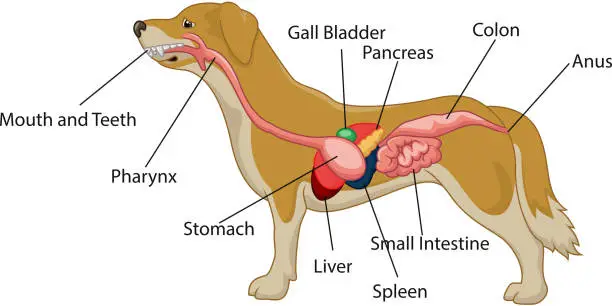Pancreatitis is a serious and potentially life-threatening condition that can affect dogs of all breeds, sizes, and ages. As a dog owner, understanding this condition is crucial to ensuring your furry friend stays healthy and happy. In this comprehensive guide, we’ll explore everything you need to know about pancreatitis in dogs, including its causes, symptoms, treatment options, and prevention tips.
What is Pancreatitis in Dogs?
The pancreas is a vital organ located near the stomach and small intestine. It plays a dual role in producing digestive enzymes to break down food and regulating blood sugar levels through insulin production. Pancreatitis in dogs occurs when the pancreas becomes inflamed, causing digestive enzymes to leak into the abdominal cavity. This can lead to tissue damage, infection, and even organ failure if left untreated.

Pancreatitis can be acute pancreatitis in dogs (sudden onset) or chronic pancreatitis in dogs (long-term). Both forms require immediate veterinary attention to prevent complications.
Causes of Pancreatitis in Dogs
While the exact cause of pancreatitis is often unknown, several factors can contribute to its development:
- High-Fat Diets: Feeding your dog fatty foods, table scraps, or greasy treats can trigger pancreatitis.
- Obesity: Overweight dogs are at a higher risk of developing this condition.
- Trauma or Injury: Physical trauma to the abdomen can damage the pancreas.
- Medications: Certain drugs, such as corticosteroids, can increase the risk.
- Underlying Health Conditions: Diseases like diabetes, hypothyroidism, or Cushing’s disease may predispose dogs to pancreatitis.
- Genetics: Some breeds, such as Miniature Schnauzers, Yorkshire Terriers, and Cocker Spaniels, are more prone to pancreatitis.
Symptoms of Pancreatitis in Dogs
Recognizing the symptoms of pancreatitis in dogs early can save your dog’s life. Common symptoms include:
- Vomiting: Frequent or severe vomiting is a hallmark sign.
- Abdominal Pain: Your dog may show discomfort, such as a hunched back or reluctance to move.
- Loss of Appetite: Refusing to eat or drink is common.
- Lethargy: Your dog may appear unusually tired or weak.
- Diarrhea: This may be accompanied by greasy or bloody stools.
- Fever: A high body temperature can indicate inflammation or infection.
- Dehydration: Dry gums and excessive panting are signs of dehydration.
If you notice any of these symptoms, contact your veterinarian immediately.
Diagnosing Pancreatitis in Dogs
Diagnosing pancreatitis involves a combination of physical exams, blood tests, and imaging. Your vet may perform:
- Blood Tests: To check for elevated pancreatic enzymes (amylase and lipase).
- Ultrasound: To visualize inflammation or damage to the pancreas.
- X-rays: To rule out other conditions, such as intestinal blockages.
- Specific Pancreatic Tests: The cPLI (canine pancreatic lipase immunoreactivity) test is highly accurate for diagnosing pancreatitis.
Preventing Pancreatitis in Dogs
Preventing pancreatitis in dogs is always better than cure. Here are some dog health tips to reduce your dog’s risk of pancreatitis:
- Avoid Fatty Foods: Stick to a balanced, high-quality diet and avoid table scraps.
- Maintain a Healthy Weight: Regular exercise and portion control can prevent obesity.
- Monitor Medications: Discuss potential side effects with your vet.
- Regular Check-Ups: Routine vet visits can help detect underlying conditions early.
- Breed-Specific Care: If you have a breed prone to pancreatitis, be extra vigilant about their diet and health.
Dog Pancreatitis Diet
A dog pancreatitis diet is critical for managing and preventing this condition. The best diet for dogs with pancreatitis is low in fat and easy to digest. Consider the following:
- Prescription Diets: Many brands offer low-fat formulas specifically for dogs with pancreatitis.
- Home-Cooked Meals: Boiled chicken (skinless), white rice, and plain pumpkin are gentle on the pancreas.
- Small, Frequent Meals: Feeding smaller portions throughout the day can reduce strain on the pancreas.
- Avoid Treats: High-fat treats should be replaced with low-fat alternatives like carrots or green beans.
Always consult your vet before making dietary changes.
When to See a Vet
If your dog shows any signs of pancreatitis, don’t wait. Early intervention can make a significant difference in their recovery. Contact your vet immediately if you notice:
- Persistent vomiting or diarrhea
- Severe abdominal pain
- Lethargy or weakness
- Loss of appetite for more than 24 hours
Conclusion
Pancreatitis in dogs is a serious condition that requires prompt attention and care. By understanding the causes of pancreatitis in dogs, recognizing the symptoms of pancreatitis in dogs, and exploring treatment for pancreatitis in dogs, you can take proactive steps to protect your dog’s health. Remember, preventing pancreatitis in dogs is key—avoid fatty foods, maintain a healthy weight, and schedule regular vet check-ups.
If you suspect your dog may have pancreatitis, don’t hesitate to seek veterinary care. Early diagnosis and treatment can significantly improve your dog’s chances of a full recovery.